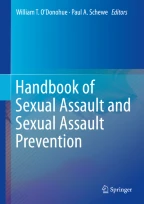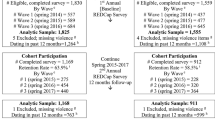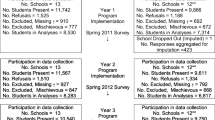Bystander Program Effectiveness: A Review of the Evidence in Educational Settings (2007–2018)

Bystander interventions are now recognized as promising programming to reduce violence. Tenants of bystander programs include training those who may be “passive” bystanders to become engaged or “active” bystanders by learning to (1) recognize potentially violent or otherwise dangerous situations and (2) act to prevent harm or otherwise defuse the situation. Bystander actions may occur before, during or after a potentially dangerous situation. Here, the effectiveness of 12 bystander programs, reported in 23 publications between 2007 and 2017, were reviewed. Bystander programs are hypothesized to increase bystander efficacy, intentions, or behaviors, and reduce violence acceptance and violence perpetration and victimization. The majority of the bystander programs reviewed were implemented in college settings and used a rigorous experimental design. Receipt of bystander training was associated with an increase in bystander efficacy or intentions (9 of 10 programs reviewed) or bystander behaviors (seven of nine programs). Reductions in violence acceptance were noted in 7 of 11 programs reviewed. Only four programs provided data to evaluate bystander effectiveness to reduce violence; all four found reductions in either sexual violence, sexual harassment, or dating violence. This systematic review of findings from 12 different bystander programs supports the promising nature of bystander programs to increase reports of bystander behaviors. Additional research is needed to understand how and when bystander programming works to reduce violence acceptance and ultimately violence perpetration and victimization.
This is a preview of subscription content, log in via an institution to check access.
Access this chapter
Subscribe and save
Springer+ Basic
€32.70 /Month
- Get 10 units per month
- Download Article/Chapter or eBook
- 1 Unit = 1 Article or 1 Chapter
- Cancel anytime
Buy Now
Price includes VAT (France)
eBook EUR 96.29 Price includes VAT (France)
Softcover Book EUR 126.59 Price includes VAT (France)
Hardcover Book EUR 179.34 Price includes VAT (France)
Tax calculation will be finalised at checkout
Purchases are for personal use only
Similar content being viewed by others

Post Cluster-Randomized Controlled Trial: Longer-Term Efficacy of a Bystander Program to Reduce Violence Perpetration and Victimization in a Prospective Cohort
Article 13 August 2024

Bystander Program Effectiveness to Reduce Violence Acceptance: RCT in High Schools
Article Open access 02 April 2018

Bystander Program Effectiveness to Reduce Violence and Violence Acceptance Within Sexual Minority Male and Female High School Students Using a Cluster RCT
Article 06 January 2020
References
- Ahrens, C. E., Rich, M. D., & Ullman, J. B. (2011). Rehearsing for real life: The impact of the InterACT sexual assault prevention program on self-reported likelihood of engaging in bystander interventions. Violence Against Women, 17(6), 760–776. https://doi.org/10.1177/1077801211410212ArticleGoogle Scholar
- Alegria-Flores, K., Raker, K., Pleasants, R. K., Weaver, M. A., & Weinberger, M. (2017). Preventing interpersonal violence on college campuses: The effect of one act training on bystander intervention. Journal of Interpersonal Violence, 32(7), 1103–1126. https://doi.org/10.1177/0886260515587666ArticleGoogle Scholar
- Banyard, V. L. (2015). Toward the next generation of bystander prevention of sexual and relationship violence: Action coils to engage communities (Springer Briefs in Criminology). Cham: Springer. https://doi.org/10.1007/978-3-319-23171-6BookGoogle Scholar
- Banyard, V. L., Eckstein, R. P., & Moynihan, M. M. (2010). Sexual violence prevention: The role of stages of change. Journal of Interpersonal Violence, 25(1), 111–135. https://doi.org/10.1177/0886260508329123ArticleGoogle Scholar
- Banyard, V. L., Moynihan, M. M., & Crossman, M. T. (2009). Reducing sexual violence on campus: The role of student leaders as empowered bystanders. Journal of College Student Development, 50(4), 446–457. https://doi.org/10.1353/csd.0.0083ArticleGoogle Scholar
- Banyard, V. L., Moynihan, M. M., & Plante, E. G. (2007). Sexual violence prevention through bystander education: An experimental evaluation. Journal of Community Psychology, 35(4), 463–481. https://doi.org/10.1002/jcop.20159ArticleGoogle Scholar
- Cares, A. C., Banyard, V. L., Moynihan, M. M., Williams, L. M., Potter, S. J., & Stapleton, J. G. (2015). Changing attitudes about being a bystander to violence: Translating an in-person sexual violence prevention program to a new campus. Violence Against Women, 21(2), 165–187. https://doi.org/10.1177/1077801214564681ArticleGoogle Scholar
- Coker, A. L., Bush, H. M., Brancato, C. J., Clear, E. R., & Recktenwald, E. A. (2018). Bystander program effectiveness to reduce violence acceptance: RCT in high schools. Journal of Family Violence. 02 April, 2018, 1–12. https://doi.org/10.1007/s10896-018-9961-8ArticleGoogle Scholar
- Coker, A. L., Bush, H. M., Cook-Craig, P. G., DeGue, S. A., Clear, E. R., Brancato, C. J., … Recktenwald, E. A. (2017). RCT testing bystander effectiveness to reduce violence. American Journal of Preventive Medicine, 52(5), 566–578. https://doi.org/10.1016/j.amepre.2017.01.020ArticleGoogle Scholar
- Coker, A. L., Bush, H. M., Fisher, B. S., Swan, S. C., Williams, C. M., Clear, E. R., & DeGue, S. (2016). Multi-college bystander intervention evaluation for violence prevention. American Journal of Preventive Medicine, 50(3), 295–302. https://doi.org/10.1016/j.amepre.2015.08.034ArticleGoogle Scholar
- Coker, A. L., Cook-Craig, P. G., Williams, C. M., Fisher, B. S., Clear, E. R., Garcia, L. S., & Hegge, L. M. (2011). Evaluation of Green dot: An active bystander intervention to reduce sexual violence on college campuses. Violence Against Women, 17(6), 777–796. https://doi.org/10.1177/1077801211410264ArticleGoogle Scholar
- Coker, A. L., Fisher, B. S., Bush, H. M., Swan, S. C., Williams, C. M., Clear, E. R., & DeGue, S. (2015). Evaluation of the Green dot bystander intervention to reduce interpersonal violence among college students across three campuses. Violence Against Women, 21(12), 1507–1527. https://doi.org/10.1177/1077801214545284ArticleGoogle Scholar
- Cook-Craig, P. G., Millspaugh, P. H., Recktenwald, E. A., Kelly, N. C., Hegge, L. M., Coker, A. L., & Pletcher, T. S. (2014). From empower to Green dot: Successful strategies and lessons learned in developing comprehensive sexual violence primary prevention programming. Violence Against Women, 20(10), 1162–1178. https://doi.org/10.1177/1077801214551286ArticleGoogle Scholar
- Cultureofrespect.org. (2016). Cultureofrespect.org. Google Scholar
- DeGue, S., Valle, L. A., Holt, M. K., Massetti, G. M., Matjasko, J. L., & Tharp, A. T. (2014). A systematic review of primary prevention strategies for sexual violence perpetration. Aggression and Violent Behavior, 19(4), 346–362. https://doi.org/10.1016/j.avb.2014.05.004ArticleGoogle Scholar
- Donovan, E., Mahapatra, P. D., Green, T. C., Chiauzzi, E., McHugh, K., & Hemm, A. (2015). Efficacy of an online intervention to reduce alcohol-related risks among community college students. Addiction Research & Theory, 23(5), 437–447. https://doi.org/10.3109/16066359.2015.1043625ArticleGoogle Scholar
- Elias-Lambert, N., & Black, B. M. (2016). Bystander sexual violence prevention program: Outcomes for high and low risk university men. Journal of Interpersonal Violence, 31(19), 3211–3235. https://doi.org/10.1177/0886260515584346ArticleGoogle Scholar
- Foubert, J. D., Langhinrichsen-Rohling, J., Brasfield, H., & Hill, B. (2010). Effects of a rape awareness program on college women: Increasing bystander efficacy and willingness to intervene. Journal of Community Psychology, 38(7), 813–827. https://doi.org/10.1002/jcop.20397ArticleGoogle Scholar
- Gidycz, C. A., Orchowski, L. M., & Berkowitz, A. D. (2011). Preventing sexual aggression among college men: An evaluation of a social norms and bystander intervention program. Violence Against Women, 17(6), 720–742. https://doi.org/10.1177/1077801211409727ArticleGoogle Scholar
- Jaime, M. D., Stocking, M., Freire, K., Perkinson, L., Ciaravino, S., & Miller, E. (2016). Using a domestic and sexual violence prevention advocate to implement a dating violence prevention program with athletes. Health Education Research, 31(6), 679–696. https://doi.org/10.1093/her/cyw045ArticleGoogle Scholar
- Jouriles, E. N., Krauss, A., Vu, N. L., Banyard, V. L., & McDonald, R. (2018). Bystander programs addressing sexual violence on college campuses: A systematic review and meta-analysis of program outcomes and delivery methods. Journal of American College Health, 09 March, 2018, 1–10. https://doi.org/10.1080/07448481.2018.1431906ArticleGoogle Scholar
- Katz, J., Heisterkamp, H. A., & Fleming, W. M. (2011). The social justice roots of the mentors in violence prevention model and its application in a high school setting. Violence Against Women, 17(6), 684–702. https://doi.org/10.1177/1077801211409725ArticleGoogle Scholar
- Kleinsasser, A., Jouriles, E. N., McDonald, R., & Rosenfield, D. (2015). An online bystander Intervetion program for the prevention of sexual violence. Psychology of Violence, 5(3), 227–235. https://doi.org/10.1037/a0037393ArticleGoogle Scholar
- Langhinrichsen-Rohling, J., Foubert, J. D., Brasfield, H. M., Hill, B., & Shelley-Tremblay, S. (2011). The Men’s program: Does it impact college Men’s self-reported bystander efficacy and willingness to intervene? Violence Against Women, 17(6), 743–759. https://doi.org/10.1177/1077801211409728ArticleGoogle Scholar
- Latané, B., & Rodin, J. (1969). A lady in distress: Inhibiting effects of friends and strangers on bystander intervention. Journal of Experimental Social Psychology, 5, 189–202. ArticleGoogle Scholar
- McMahon, S., Allen, C. T., Postmus, J. L., McMahon, S. M., Peterson, N. A., & Hoffman, M. L. (2014). Measuring bystander attitudes and behavior to prevent sexual violence. Journal of American College Health, 62(1), 58–66. https://doi.org/10.1080/07448481.2013.849258ArticleGoogle Scholar
- McMahon, S., Postmus, J. L., Warrener, C., & Koenick, R. A. (2014). Utilizing peer education theater for the primary prevention of sexual violence on college campuses. Journal of College Student Development, 55(1), 78–85. https://doi.org/10.1353/csd.2014.0001ArticleGoogle Scholar
- McMahon, S., Winter, S. C., Palmer, J. E., Postmus, J. L., Peterson, N. A., Zucker, S., & Koenick, R. (2015). A randomized controlled trial of a multi-dose bystander intervention program using peer education theater. Heather Education Research, 30(4), 554–568. https://doi.org/10.1093/her/cyv022ArticleGoogle Scholar
- Midgett, A., Doumas, D., Sears, D., Lunquist, A., & Hausheer, R. (2015). A bystander bullying Psychoeducation program with middle school students: A preliminary report. The Progessional Counselor, 5(4), 486–500. https://doi.org/10.15241/am.5.4.486ArticleGoogle Scholar
- Miller, E., Tancredi, D. J., McCauley, H. L., Decker, M. R., Virata, M. C. D., Anderson, H. A., … Silverman, J. G. (2013). One-year follow-up of a coach-delivered dating violence prevention program: A cluster randomized controlled trial. American Journal of Preventive Medicine, 45(1), 108–112. https://doi.org/10.1016/j.amepre.2013.03.007ArticleGoogle Scholar
- Miller, E., Tancredi, D. J., McCauley, H. L., Decker, M. R., Virata, M. D., Anderson, H. A., … Silverman, J. G. (2012). "coaching boys into men": A cluster-randomized controlled trial of a dating violence prevention program. Journal of Adolescent Health, 51(5), 431–438. https://doi.org/10.1016/j.jadohealth.2012.01.018ArticleGoogle Scholar
- Moynihan, M. M., Banyard, V. L., Arnold, J. S., Eckstein, R. P., & Stapleton, J. G. (2010). Engaging intercollegiate athletes in preventing and intervening in sexual and intimate partner violence. Journal of American College Health, 59(3), 197–204. https://doi.org/10.1080/07448481.2010.502195ArticleGoogle Scholar
- Moynihan, M. M., Banyard, V. L., Cares, A. C., Potter, S. J., Williams, L. M., & Stapleton, J. G. (2015). Encouraging responses in sexual and relationship violence prevention: What program effects remain 1 year later. Journal of Interpersonal Violence, 30(1), 110–132. https://doi.org/10.1177/0886260514532719ArticleGoogle Scholar
- Potter, S. J., Moynihan, M. M., Stapleton, J. G., & Banyard, V. L. (2009). Empowering bystanders to prevent campus violence against women. Violence Against Women, 15(1), 106–121. https://doi.org/10.1177/1077801208327482ArticleGoogle Scholar
- Salazar, L. F., Vivolo-Kantor, A., Hardin, J., & Berkowitz, A. (2014). A web-based sexual violence bystander intervention for male college students: Randomized controlled trial. Journal of Medical Internet Research, 16(9), e203. https://doi.org/10.2196/jmir.3426ArticleGoogle Scholar
- Sargent, K. S., Jouriles, E. N., Rosenfield, D., & McDonald, R. (2017). A high school-based evaluation of TakeCARE, a video bystander program to prevent adolescent relationship violence. Journal of Youth and Adolescence, 46(3), 633–643. https://doi.org/10.1007/s10964-016-0622-zArticleGoogle Scholar
- Storer, H. L., Casey, E., & Herrenkohl, T. (2016). Efficacy of bystander programs to prevent dating abuse among youth and young adults: A review of the literature. Trauma, Violence, and Abuse, 17(3), 256–269. https://doi.org/10.1177/1524838015584361ArticleGoogle Scholar
- Williams, C. M., Cook-Craig, P. G., Bush, H. M., Clear, E. R., Lewis, A. M., Garcia, L. S., … Fisher, B. S. (2014). Victimization and perpetration of unwanted sexual activities among high school students: Frequency and correlates. Violence Against Women, 20(10), 1239–1257. https://doi.org/10.1177/1077801214551575ArticleGoogle Scholar
- Zapp, D., Buelow, R., Soutiea, L., Berkowitz, A., & DeJong, W. (2018). Exploring the potential campus-level impact of online universal sexual assault prevention education. Journal of Interpersonal Violence, 26, 1–22. https://doi.org/10.1177/0886260518762449ArticleGoogle Scholar
Author information
Authors and Affiliations
- Office of Research Integrity, University of Kentucky, Lexington, KY, USA Samuel C. Bell & Ann L. Coker
- College of Public Health, University of Kentucky, Lexington, KY, USA Emily R. Clear
- Samuel C. Bell




